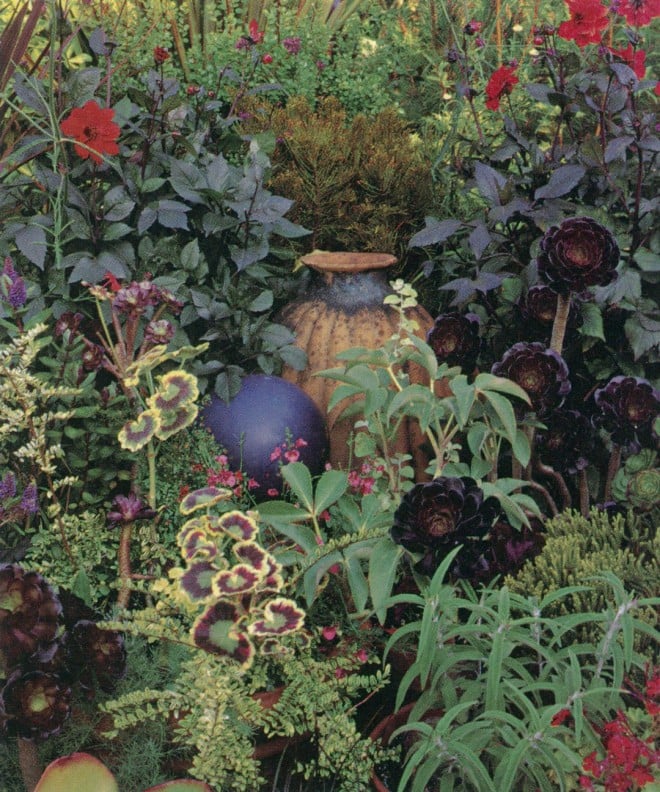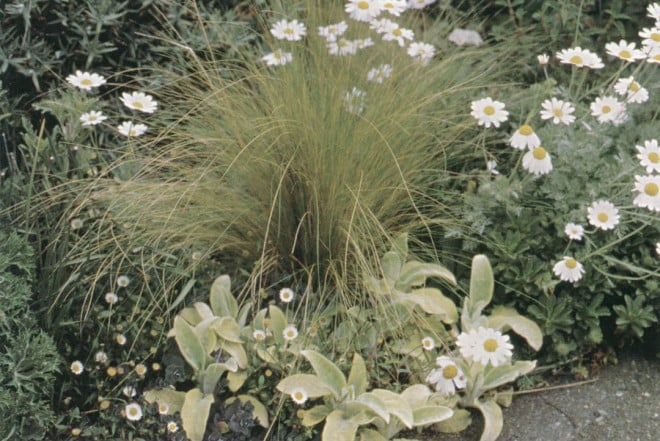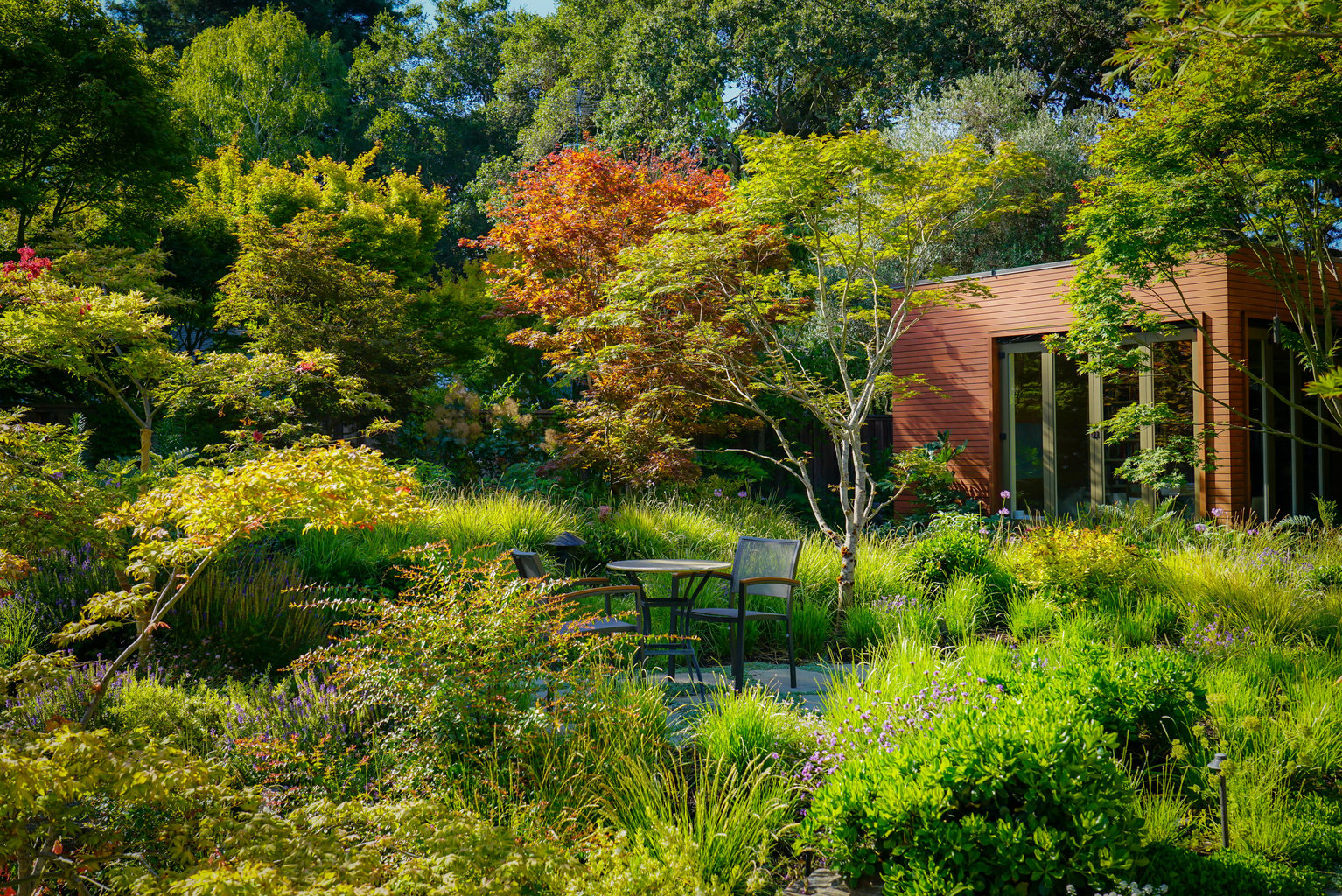
Gardening a One-lane Blacktop

Contributor

Taking a fresh look at a strictly utilitarian asphalt driveway opened the way for a new garden of mediterranean plants in Victoria, considered by locals to be the most northerly of the West Coast’s mediterranean climate regions.
Twelve years ago, I found my present house in Victoria, BC, and began to develop a new garden around it. At the same time, I became acquainted with members of the Victoria Hardy Plant Group, true plant enthusiasts who constantly stretch the definition of the word “hardy.” These keen plantspeople—the “hardy planters”—shared their enthusiasm, their plants, and, as it turned out, their addiction. It is a blissful state when you first fall in love, and my new love was plants. Everything was new and wonderful. I wasn’t jaded nor particularly cautious. I simply wanted to try to grow everything I saw that I liked—and that was quite a bit.
My new property was one-half acre in size. Most of the established garden consisted of a manicured lawn and azaleas growing under a canopy of mature Garry oaks (Quercus garryana). This area became home to many of my new plant treasures but was not a satisfactory spot for all the mediterranean plants I also longed to try. I took a second look at my driveway.
My house was built in the 1950s, a decade that, stylistically, I remember more for its automotive than for its horticultural design. My no-step, ranch-style house had a “cadillac” of an asphalt driveway. It was about 200 feet long and thirty feet wide. The driveway occupied the sunniest area on the property, sheltered the entire length by a mature thuya hedge. Working on the premise that limitations equal possibilities, my possibilities seemed endless. I began to remove the asphalt.

Picking Away at Asphalt
During the first summer, I had placed a collection of pots on the driveway by my back door. As my collections grew, and to save the cost of more containers, I made a few tentative holes in the asphalt with a pick. These amounted to recessed containers. The roadbase below the asphalt was lightly amended with compost and the holes were planted with Euphorbia characias and tree lupine (Lupinus arboreus). The plants thrived. The tree lupine was as happy as if it were back on a beach in California. Encouraged by my success, I wondered why I had made so few holes. That fall, I dug up my first complete driveway beds with a rented jackhammer and the help of my seventeen-year-old son.
The asphalt pavement was about one inch thick. We cut it into manageable chunks and hauled it away. The roadbase under the asphalt was a mixture of coarse gravel and sand. I dug out the beds to a depth of eight inches. Large rocks that were uncovered during the digging provided a suitable edging for what was to become a raised bed. Compost was mixed with three-fourths of the roadbase, at a ratio of equal parts compost and roadbase. I used the remaining gravel and sand roadbase for topdressing.
Plantings in this bed became a wonderfully textural mix. The bed is backed by a twenty-foot mugo pine (Pinus mugo), which is very drought tolerant. I have added dwarf white pine (Pinus strobus ‘Nana’), Hippophae rhamnoides, Vestia foetida, and three buddlejas (Buddleja fallowiana var. alba, B. davidii ‘Harlequin’, and the large fuzzy-leafed B. yunnanensis). Genista maderensis flowers for three months every spring, and the bush poppy (Dendromecon) is now ten feet high, reliably blooming from April until November frosts. Flowers of Cistus laurifolius match those of Rosa x alba ‘Semiplena’, which stretches into the mugo pine along with Clematis connata. A variety of alliums and species tulips poke out through a matrix of sub-shrubs and perennials that include Rosmarinus pinifolius, various rock rose-like halimiums, Phlomis russeliana, Parahebe perfoliata, and Silene maritima ‘Plena’. The center of the bed is dominated by a wonderful evergreen grass from Morocco, Ampelodesmos mauritanicus, which blooms every year on stalks that reach to eight feet. I was not afraid of asphalt now, so I began digging more beds.

A Craving for More Space
The garden space by the back door was expanded next. Because it functioned as a main entrance, I searched for a more formal edging material and was happy to find some pieces of hand-cut granite left over from the building of the province’s parliament buildings. This bed was planted with phormiums, olearias, Colutea arborescens, and Carex buchananii. My terracotta pots remain an integral part of this planting mix because they allow me to play with changes of height and to incorporate seasonal plantings such as ‘Princess Irene’ tulips, blue violas, and wallflowers every spring, and Dahlia ‘Ellen Houston’ along with various aeoniums and echeverias all summer.
Along the fifty-foot length of the house, I removed at least another six-foot width of asphalt. This made room for purple hopseed bush (Dodonaea viscosa ‘Purpurea’), Pseudopanax lessonii, Euphorbia mellifera, Phlomis cretica, Buddleja salviifolia, Corokia x virgata ‘Bronze King’, and assorted rock roses (Cistus) and hebes. Favorite edging plants include Anthemis cupaniana, Euphorbia myrsinites, Stachys byzantina ‘Primose Heron’, and Diplarrhena moraea. A South African honeybush (Melianthus major) flowers every other year and has spread to cover about five feet of ground. I plant echiums mostly for their tropical-looking foliage; last year, because of the extremely dry winter, Echium pininana did not rot, but threw up flower spikes to over ten feet tall. This year, Ovens wattle (Acacia pravissima), grown from seed by a fellow hardy planter, is giving me the most pleasure in this garden bed. A hard winter will surely knock it back, but I am happy to have gotten to know it and consider it well worth the gamble.

On a hot summer day with nothing to do, you can easily chip away at soft asphalt with any sharp garden tool if you feel you need a bit more planting space and don’t have a pick or a jackhammer at hand. I did this and created a small bed for Iris pallida ‘Aurea Variegata’, Chrysanthemum hosmariense, and Artemisia canescens. Another pocket, about a foot across, became a home for Hebe pimeleoides ‘Quicksilver’, and Hieracium waldsteinii, the two providing good contrast in form and foliage. The most recent pockets have been made down the center of the driveway. Plantings here include thymes, hen-and-chicks (Sempervivum), veronicas , townsendias, sunroses (Helianthemum), and low zauchnerias (Epilobium)—anything I can drive over, since this is still a functioning driveway.

Tough Plants
I am constantly amazed at how tough many of these plants are and how they manage to find footholds in the smallest cracks in the asphalt, choosing for themselves where they like to grow best. Stipa tenuissima is easily removed if unwanted, but who would not want the wonderful bleached tresses of this grass softening the grey surfaces. The same is true for Eryngium bourgatti and Erigeron karvinskianus, both seeding themselves in the most unlikely places.
I planned these mediterranean beds for my own enjoyment and to experiment with what might thrive in my protected corner of Victoria. The lean soil of the driveway has been a real asset; I think it has been the single most important reason that so many plants have survived winter temperatures that fall occasionally to –8° C (18° F). I did not begin these beds with the idea that they would be particularly low maintenance, but they really do require less care than the rest of my garden. This was particularly noticeable after the harsh water restrictions that were imposed in Victoria last year, following a winter with only about fifteen inches of rain (normal rainfall here is about twenty-four inches, falling between October and June). Watering in these beds has been minimal every summer. I never stake anything here and divide plants infrequently. There are a few climbing roses and Clematis viticella in the mix that I do topdress with manure every spring, but overall care is limited. I only realize now, as I write this, that pests (including slugs), are almost non-existent, and I use no pesticides.
My heart still races when I see a new and desirable plant, but the sheer volume of new plants to try has definitely shrunk over the last five years. I have entered that more mature gardening phase now—learning to edit and refine. It has all been great fun and I do envy anyone starting afresh on their own mediterranean adventure.
Share:
Social Media
Garden Futurist Podcast
Most Popular
Videos
Topics
Related Posts

Low Maintenance Gardens – Better for Pollinators and People
Autumn 2022 “I come out every day. It’s therapy, my meditation.” Janet’s young garden transformed from overgrown, invasive plants to mostly natives. The dailiness of

Invasive Plants Are Still Being Sold: Preventing Noxious Weeds in Your Landscape
Autumn 2022 With so many beautiful ornamental plant species and cultivars throughout California and the Pacific Northwest, how do you decide which ones to include

Garden Design in Steppe with Transforming Landscapes with Garden Futurist Emmanuel Didier
Summer 2022 Listen to full Garden Futurist: Episode XVII podcast here. Emmanuel Didier, Principal and Creative Director at Didier Design Studio is a leading figure

Seslerias: Versatile Groundcover Meadow Grasses
Summer 2022 Without question, the most beautiful and versatile of all the groundcover meadow grasses are the moor grasses (Sesleria). Moor grasses tick off all










Responses